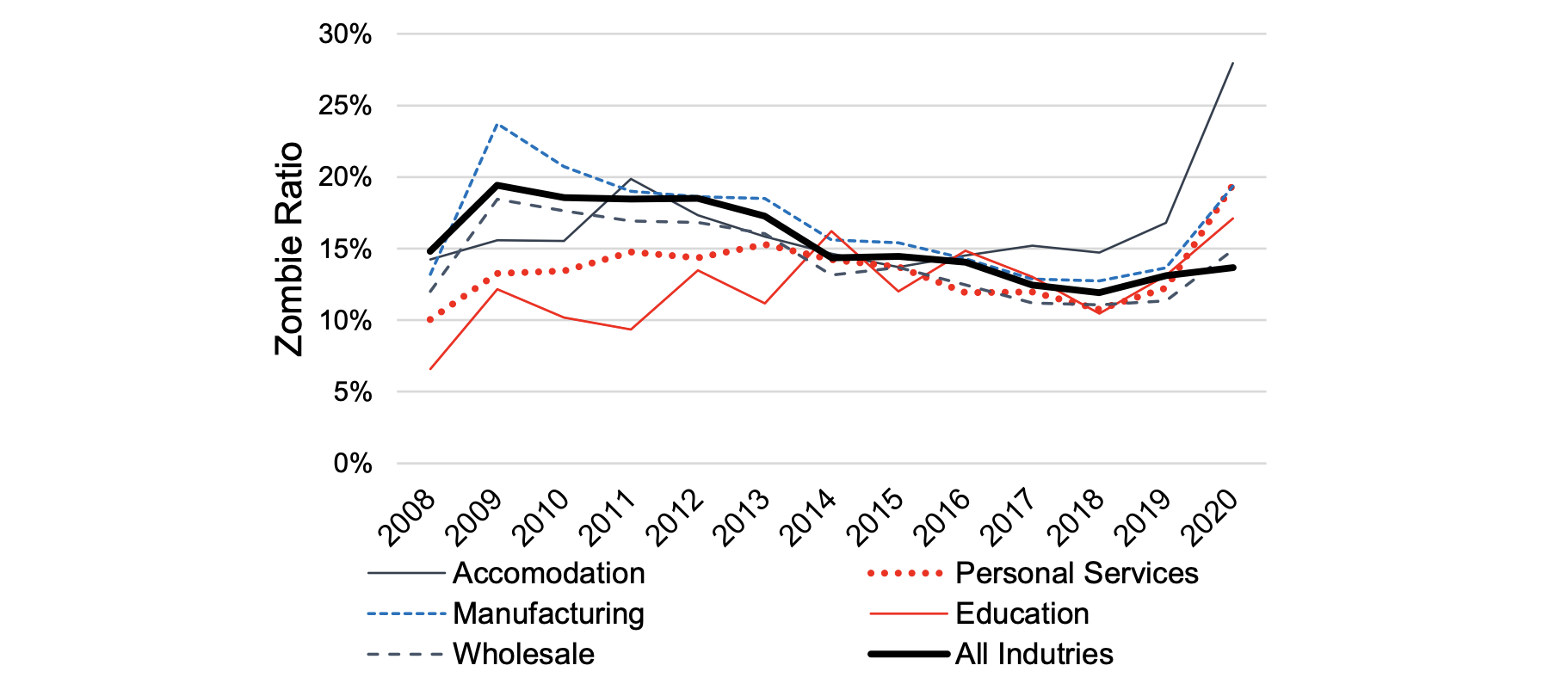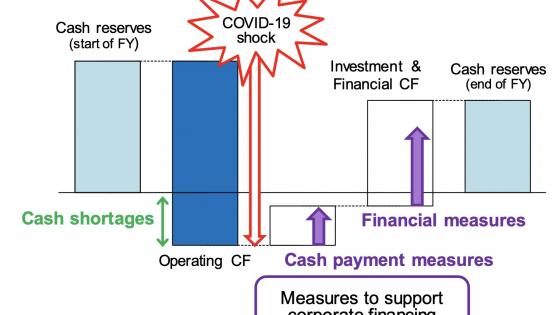Two years have passed since the COVID-19 pandemic shock permeated the globe. The pandemic constituted a massive shock to the Japanese economy, as in other countries, posing a significant threat to the business continuity of firms. With timely and strong government support, firm exit rates have remained remarkably low and job losses associated with the pandemic have been contained. At the same time, the low level of firm exits raises concerns about the zombification of Japanese firms, the extent to which the government support is allowing insolvent firms to continue, and the extent to which previously healthier firms became vulnerable after the pandemic shock. In this column, using a firm-level dataset from Tokyo Shoko Research (TSR), a credit rating agency, on firm exits and balance sheets up to 2021, we document the impact of the COVID-19 pandemic on corporate exit patterns and debt structure.
A weaker cleansing mechanism during the pandemic
We examine the firm exit rates in terms of its overall financial healthiness. We use a variable called ‘score’, with a value between 0 and 100 reflecting financial health, management, and other firm-related information assessed by the TSR. A higher value implies that a firm is assessed to be financially healthier, from the perspective of a credit rating agency. To see the correlation between firm healthiness and firm exit rate, Figure 1 shows firm exit rates for voluntary exit and bankruptcy rates for four bins categorised by a firm’s score in the periods before and during pandemic. Since information on firms is provided by TSR at the end of September, we see two periods during pandemic: the period from October 2019 to September 2020, and the period from October 2020 to September 2021. In Japan, it has been established that the majority of firm exits are voluntary rather than bankruptcies and the bankruptcy rate is decreasing over time (Hong et al. 2020). In the figure, a negative correlation with a downward slope means that healthy firms are less likely to exit, and the extent of the slope implies the size of the cleansing mechanism. The panel on the left shows that the slope remained relatively stable in the former period (October 2019 to September 2020) but flattened in the latter period (October 2020 to September 2021), suggesting that the cleansing mechanism from voluntary exit weakened, with unhealthy firms less likely to exit in the latter period. The panel on the right shows that the bankruptcy rate was stable in the earlier period and that it declined significantly, especially for unhealthy firms, in the later period, suggesting that the cleansing mechanism weakened. These tendencies are examined by regression analysis and found to be statistically significant (Hong et al. 2022).
Figure 1 Firm exit rate by firm score
Note: The X-axis shows the quantiles of firm score, with the weakest firms (below the 25th percentile in terms of firm score) in Bin 1 and the healthiest firms (above the 75th percentile in terms of firm score) in Bin 4. For the figure on the right, the y-axis plots firm exit rates due to bankruptcy.
In addition to firm healthiness, we examine other firm characteristics known to be associated with firm exits, such as the size of firms (measured by the number of employees) and labour productivity. Before the pandemic, it was documented that smaller firms and less-productive firms were more likely to exit in Japan (Hong et al. 2020). During the pandemic, we find that these correlations weakened somewhat, with a lower rate of firm exits by smaller firms and less-productive firms than before. However, there is only one firm characteristic whose correlation with firm exits increased during the pandemic, namely, the age of owners. An important driver of firm exits in Japan, especially for voluntary firm exits, is the age of the owner (Hong et al. 2020), as ageing owners tend to decide to close their businesses due to difficulties in finding a successor. We find that firms run by elderly owners continue exiting during the pandemic as before, while the firm exit rate for young owners fell compared to the pre-pandemic periods. To summarise, the low level of firm exits at the aggregate level appears to differ based on firm characteristics.
A rise in corporate indebtedness and zombie firms, but not in all sectors
Next, we examine the change in corporate indebtedness. At the aggregate level, the increase in the long-term debt of corporations is more pronounced than that in short-term debt (Figure 2). However, an analysis using firm-level balance sheets is needed to understand the distribution of this corporate borrowing and its implications on corporate solvency.
Figure 2 Total outstanding debt: Long-term versus short-term debt, 2015Q1: 2022Q1
Source: Financial Statements Statistics of Corporations by Industry, Ministry of Finance.
Note: The dashed lines indicate a pre-pandemic trend line based on the period of 2015 to 2019 using linear interpolation.
To complement the aggregate findings, we examine the corporate indebtedness at the firm level. Here, we adopt the definition of a ‘zombie firm’ introduced by Fukuda and Nakamura (2011, 2013; hereafter ‘FN’) to distinguish firms that face severe indebtedness from healthier firms.
Figure 3 shows the time series of the zombie ratio by industry
from 2008 to 2020. The figure depicts the time series of sectors with the largest increases in zombie ratio in 2020 compared to the average of the previous three years together with that for all industries. We find that there is significant variation across sectors. The accommodation sector saw the greatest increase in zombie ratio in 2020. Interestingly, there is a significant increase in the zombie ratio in the manufacturing and wholesale category, which does not provide consumer services, and we suppose that social distancing measures have minimal effect on such industries.
Figure 3 Zombie ratio by industry
Source: TSR data. Zombie firms are defined in accordance with Fukuda and Nakamura (2011 and 2013). See footnote 3 for more details.
Conclusion and policy implications
Despite the fact that the overall bankruptcy rate remains very low, the COVID-19 pandemic appears to have negatively affected the dynamism of Japanese firms. Our first piece of evidence to support this claim is a weakened ‘cleansing mechanism’, with a reduction of firm exit rates even for less-healthy firms. Second, the proportion of ‘zombie’ firms in certain industries increased sharply during the pandemic. Policy measures should strike a careful balance between protecting firms from unexpected shocks and facilitating the exit of firms that are no longer viable. As previous studies have convincingly demonstrated, prolonging the lifelines of unviable firms will undermine the aggregate productivity and reallocations of labour and capital, dampening a swift and robust economic recovery in the post-pandemic period.
Editor’s note: The views expressed here are those of the authors and do not necessarily represent the views of the IMF, its Executive Board, or IMF management. The main research on which this column is based (Hong et al. 2022) first appeared as a Discussion Paper of the Research Institute of Economy, Trade and Industry (RIETI) of Japan.
References
Fukuda, S-I and J-I Nakamura (2011), “Why Did ‘Zombie’ Firms Recover in Japan?”, The World Economy 34(7): 1124–37.
Nakamura, J-I and S-I Fukuda (2013), “What Happened To ‘Zombie’ Firms In Japan? Re-examination For The Lost Two Decades”, Global Journal of Economics 2(2): 1-18.
Hong, G, A Ito, Y U Saito and A Thi Ngoc Nguyen (2020), “Structural Changes in Japanese Firms: Business Dynamism in an Aging Society”, IMF Working Paper Series WP/20/182.
Hong, G, A Ito, Y U Saito and A T N Nguyen (2022), “Did the COVID-19 Pandemic Create More Zombie Firms in Japan?”, RIETI Discussion Paper 22-E-072.








